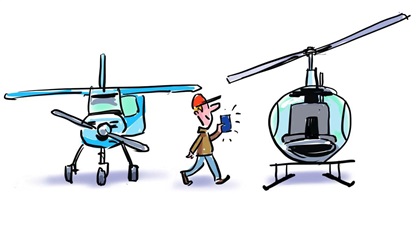 Checkride-ready
Checkride-ready
Test your knowledge of pilot privileges with these questions from the AOPA Pilot Information Center.
- True or false? A private pilot, airplane single-engine land rated, would like to add a rotorcraft helicopter rating. To solo a helicopter, she must first obtain a student pilot certificate.
- True or false? An airline transport pilot, airplane multi-
engine land rated, would like to add a rotorcraft helicopter rating. He can add that rating at the ATP level, the commercial level, or the private level. - True or false? A student pilot is limited to fixed gear,
single-engine, non-complex airplanes under 200 horsepower for initial flight training. - True or false? A long-term student pilot who has been flying for five years, has a current solo endorsement, and has been flying monthly with an instructor is exempted from the flight review requirement that most all other pilots have to comply with to act as pilot in command.
- True or false? A pilot must have at least a commercial pilot certificate to tow gliders for compensation.
 Ace
Ace
Can you correctly answer these questions from retired TWA captain and 28,000-hour pilot Barry Schiff?
- True or false? A glider pilot may fly IFR in an unpowered sailplane.
- Which takes longer, a round-trip flight with a headwind one way and a tailwind of the same speed while returning, or the same round-trip flight made instead under the influence of an equally strong crosswind?
- During standard conditions, at what altitude will atmospheric pressure be half of what it is at sea level?
- True or false? An FAA-certificated pilot may log flight time as pilot in command of an ultralight airplane.
- A cargo plane filled with uncaged, live doves is in cruise flight at 7,000 feet msl. The birds—which are at rest on the floor—suddenly fly toward the ceiling of the cabin. This causes the airplane to
A. lose altitude and lose weight.
B. lose altitude and maintain weight.
C. maintain altitude and lose weight.
D. maintain altitude and maintain weight.
Final Exam Answers
- False. She already holds a private certificate, so the instructor would just endorse her logbook to authorize solo flight in a category and class for which she is not rated. That endorsement is valid for solo flying only; no passengers are permitted to be carried, just like a student pilot limitation. (FAR 61.31[c] and [d])
- True. Ratings can be added for privileges at the same grade level as the pilot certificate held, or for privileges at a lesser level. (FAR 61.63)
- False. Although that defines the typical training airplane, student pilots are not limited to simple, fixed gear airplanes. (FAR 61.87[n] and 61.89)
- True. As long as he is actively training toward a pilot certificate with an instructor, a student pilot is exempt from the flight review requirement. (FAR 61.56[g])
- False. Private pilots may tow gliders for compensation or hire provided they meet the requirements of FAR 61.69. (FAR 61.113)
- True. To fly IFR, however, the glider must be properly equipped, and the pilot must have both a glider rating and an instrument rating valid in airplanes.
- It takes longer to make a round trip under the influence of a headwind/tailwind combination than under the influence of an equally strong crosswind.
- The atmospheric pressure at 18,000 feet on a standard day is 14.94 inches of mercury. This almost exactly half of the standard sea-level pressure of 29.92 inches.
- True. A pilot may log anything he’d like (including the time spent flying a kite or driving a tank). Such time, however, may not be used to satisfy currency or experience requirements.
- The answer is B. Doves flying toward the ceiling cause the airplane’s center of gravity (CG) to rise. Unless the forces acting upon the airplane change, it is the CG that maintains a constant altitude, not the airplane. Therefore, the airplane must descend slightly so that the overall CG does not change altitude. Aircraft weight does not change because none is removed from the aircraft. (Air from the birds’ wings beat upon the floor with a total force equal to the weight of the birds.)
Illustrations by John Holms


